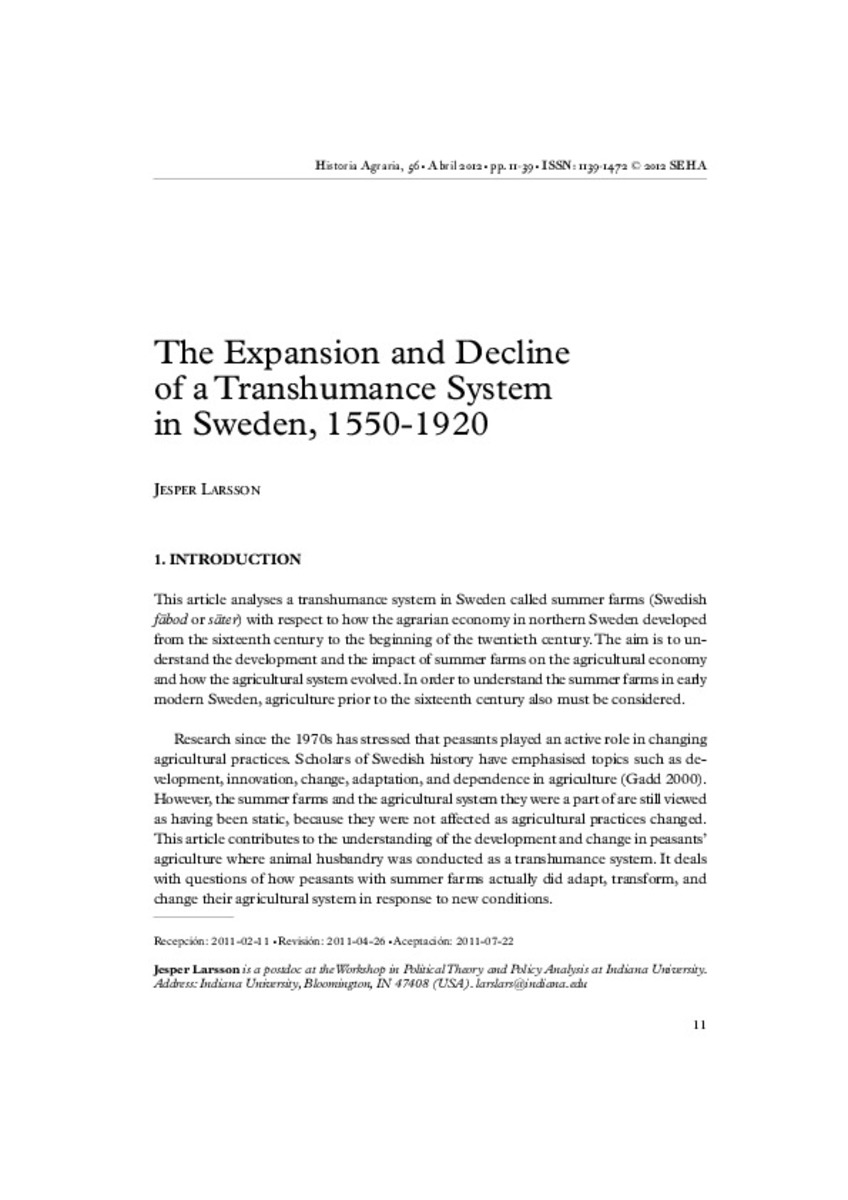Mostrar el registro sencillo del ítem
The Expansion and Decline of a Transhumance System in Sweden, 1550-1920.
| dc.contributor.author | Larsson, Jesper | |
| dc.date.accessioned | 2016-02-12T11:09:05Z | |
| dc.date.available | 2016-02-12T11:09:05Z | |
| dc.date.issued | 2012-04 | |
| dc.identifier.issn | 1139-1472 | |
| dc.identifier.uri | http://hdl.handle.net/10234/149745 | |
| dc.description.abstract | Este artículo analiza un sistema de transhumancia en Suecia, las cabañas de verano (fäbodar), en el contexto de la economía agraria del Norte del país, entre el siglo XVI y el comienzo del siglo XX. Su objetivo es comprender el impacto de estas cabañas de verano, un sistema alpino de transhumancia, en la economía agraria y su papel en el desarrollo de la agricultura. El texto trata de los aspectos económicos de las explotaciones estivales, con especial énfasis en la producción y en la organización. Para entender este sistema agrario específico, se recurre a teorías sobre la cooperación, la cultura material y la división del trabajo. Las hipótesis de la teoría de la gestión de los recursos de aprovechamiento común ocupan un lugar central en el análisis. El establecimiento de cabañas de verano permitía la expansión de la ganadería y estaba asociada a ocupaciones secundarias, y vino por ello a ser un prerrequisito para la división de los patrimonios familiares entre los integrantes de las unidades domésticas. El avance del desarrollo agrario en Suecia septentrional no habría podido tener lugar sin el despliegue del trabajo femenino en las cabañas de verano. Las ventajas del sistema agrario del Norte de Suecia se perdió cuando el pasto y la cosecha de forrajes se trasladó al labrantío durante la segunda mitad del siglo XIX. | ca_CA |
| dc.description.abstract | The paper analyses a Swedish transhumance system organised around summer farms (fäbodar), in the context of the agrarian economy in northern Sweden between the sixteenth century and the beginning of the twentieth century. The aim is to understand the impact of this alpine transhumance system in the agricultural economy and its role in the development of agriculture. The paper deals with economic aspects of summer farms, with the emphasis on production and organisation. To understand this specific agricultural system, theories about agricultural systems, the organisation of human collaboration, material culture and division of labour are used. Theories about the management of common‐pool resources (CPR’s) are central to the analysis. The establishment of summer pastures enabled the expansion of stockbreeding and was connected to secondary occupations, and was, therefore, a prerequisite for the division of property among household members. The leap in agricultural development in Northern Sweden would not have been possible without the female workforce on the summer pastureland. The advantage of the agricultural system in the north of Sweden was lost when livestock grazing and fodder collection moved to the fields during the second half of the twentieth century. | ca_CA |
| dc.format.extent | 29 p. | ca_CA |
| dc.format.mimetype | application/pdf | ca_CA |
| dc.language.iso | eng | ca_CA |
| dc.publisher | Sociedad Española de Historia Agraria (SEHA) | ca_CA |
| dc.relation.isPartOf | Historia agraria: Revista de agricultura e historia rural, nº 56, pp. 12-39 | ca_CA |
| dc.rights | © 2012 SEHA | ca_CA |
| dc.rights.uri | http://rightsstatements.org/vocab/InC/1.0/ | * |
| dc.subject | trashumancia | ca_CA |
| dc.subject | ganadería | ca_CA |
| dc.subject | comunes | ca_CA |
| dc.subject | Suecia | ca_CA |
| dc.subject | sistema agrario | ca_CA |
| dc.subject | transhumance | ca_CA |
| dc.subject | animal husbandry | ca_CA |
| dc.subject | commons | ca_CA |
| dc.subject | Sweden | ca_CA |
| dc.subject | agricultural system | ca_CA |
| dc.title | The Expansion and Decline of a Transhumance System in Sweden, 1550-1920. | ca_CA |
| dc.type | info:eu-repo/semantics/article | ca_CA |
| dc.subject.jel | N13 | ca_CA |
| dc.subject.jel | N23 | ca_CA |
| dc.subject.jel | N43 | ca_CA |
| dc.subject.jel | N53 | ca_CA |
| dc.rights.accessRights | info:eu-repo/semantics/openAccess | ca_CA |
| dc.relation.publisherVersion | http://historiaagraria.com/info_articulo.php?id=601 | ca_CA |







